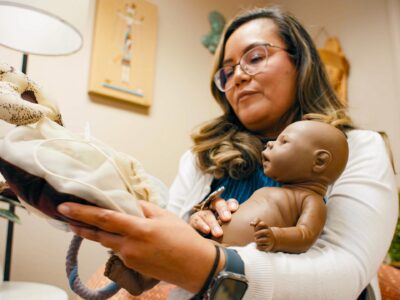The racial wealth gap persists in part because businesses owned by people of color are shut out of the capital markets at every turn.
This was true before the COVID-19 pandemic hit, according to a 2018 Small Business Administration report that found business enterprises owned by entrepreneurs of color experienced higher interest rates and more loan denials. Similar trends persisted throughout 2020.
In fact, the pandemic and subsequent business relief distribution processes put a laser-like focus on racial and economic inequities in the sector.
Early reports by W.K. Kellogg Foundation (WKKF) grantees Color Of Change and UnidosUS found that 51% of Black and Latinx small business owners surveyed had applied for less than $20,000 in assistance from the Paycheck Protection Program (PPP). Yet, only 12% said they received the full amount of assistance requested. More than three times that number — 41% — were denied assistance.
The Paycheck Protection Program was a forgivable loan program designed as a direct incentive for small businesses to keep their workers on the payroll. “Yet, 96% of Black-owned businesses are sole proprietors,” says Connie Evans, president and CEO of the Association for Enterprise Opportunity.
“Furthermore, the original distribution channel was through traditional financial institutions, and historically Black business owners do not have the banking relationships that put them in line to get those funds.”
Data released in September found that neighborhoods of color with the most cash-constrained small businesses received PPP loans last. And findings from WKKF grantee National Community Reinvestment Coalition (NCRC) research found that banks asked more questions and requested more information up front from Black or Latinx business owners compared to white business owners when seeking PPP financing — even when the Black or Latinx business owners had stronger applications.
Another important tool in driving capital to communities of color, the Community Reinvestment Act (CRA) was introduced in 1977 to counteract the effects of systemic racism in financial services by requiring banks to invest equitably in every community they serve. The result: More than $6 trillion in targeted investments have been made since its passage in the form of community development loans, investments and other services in low-income communities and communities of color.
In 2020, federal regulators with the Office of the Comptroller of the Currency (OCC) proposed new and initial regulations to the CRA that would result in less lending and investments in low-income communities and reduce accountability to these communities, effectively gutting the CRA of its core purpose.
The W.K. Kellogg Foundation, alongside 18 other philanthropic leaders representing the Presidents’ Council on Impact Investing, called on regulators in April 2020 “to indefinitely delay the rulemaking process for the [CRA], especially given the coronavirus pandemic’s disproportionate impact on the low- and moderate-income neighborhoods that the CRA is designed to serve.”
While the Federal Deposit Insurance Corp. (FDIC) pulled out of the OCC rule-making process in response to the broader wave of push-back at the proposed rules, federal regulators reportedly continue to map out new rules. Under the circumstances, the Kellogg Foundation will be tracking this closely to ensure that children and families have equitable opportunities to thrive in their communities.
Leading to keep businesses and their communities viable

Connie Evans
President and CEO, Association for Enterprise Opportunity

Lisa Mensah
President and CEO, Opportunity Finance Network
At a time when one report after another shows that Black and Brown-owned businesses have been hardest-hit by COVID-19 and the related economic crisis, WKKF grantees Association for Enterprise Opportunity (AEO) and Opportunity Finance Network (OFN) — led by Evans and Lisa Mensah, respectively — worked tirelessly to keep businesses and communities afloat.
If surviving was the primary goal, Evans and Mensah considered positioning businesses for success post-pandemic a close second.
For these leaders, advancing racial equity is not a zero-sum game. They see it as a win-win strategy essential to improving stability and growth for businesses of color and increasing economic opportunity for all.
“We are in a moment of a national, racial reawakening. Now is the moment to reckon with our history, and expose and dismantle structural racism,” says Lisa Mensah, president and CEO of OFN. “That means addressing true barriers: Not just legal but looking at how we support our institutions and stop organizing the economy in a way that keeps people out.
“Systems of capital have often been closed to the progress of minorities, and we must fight the kind of financial [systems] that have held people back,” she says. “Our community development financial institutions (CDFIs) rebuild communities and put ownership back in the hands of community members — we have been doing so for 40 years and are ready to do more.”
“We are in a moment of a national, racial reawakening. Now is the moment to reckon with our history, and expose and dismantle structural racism."
Lisa Mensah, President & CEO of Opportunity Finance Network Tweet
Removing barriers to capital
With WKKF support, AEO launched a trusted technical assistance program to help Black-owned, small businesses grow and create jobs in low-income communities using scalable and technology-centric solutions. The white/Black wealth gap is 13:1, but that wealth disparity shrinks to 3:1 when comparing white and Black business owners.
Black business ownership accelerates closing the wealth gap. Because of this dynamic, Evans says AEO is deliberate about advancing racial equity as a strategy for economic growth, and not just as a matter of social justice.
During the pandemic, the organization doubled-down on its strategy. “We immediately stood-up the Page 30 Coalition — named from page 30 of the Coronavirus Aid, Relief and Economic Security (CARES) Act, which says it is the intention of Congress that these resources are prioritized for low-wealth communities, women, veterans and business owners of color — to have a voice in CARES implementation,” she says. But that alone wasn’t going to ensure Black businesses survived the pandemic crises.
Association for Enterprise Opportunity worked to keep Black-owned businesses stable with a $10 million grant fund, working in partnership with PayPal. Since then, they have managed an additional $200 million in grants to Black-owned businesses from various partners. Additionally, the organization provided support beyond funding and offered technical assistance, helping businesses set up websites, stabilizing their intellectual property and setting up new back-office support systems.
Evans and her team were not alone in helping stabilize Black businesses.
Opportunity Finance Network moved to support its more than 300 CDFI members, many of which are small business lenders. “We lend where it counts,” Mensah says. “And the calls our members were receiving from borrowers showed a need for liquidity. People needed to keep their cash and be able to pay people as shocks hit businesses.”
Among the ways OFN has supported its members is through corporate partnerships. In March, OFN partnered with Google to create a fund ($170 million as debt funding; $10 million as grant funding) to help CDFIs working with businesses impacted by COVID-19. And at OFN’s Annual Conference in November, Mensah joined Twitter CFO Ned Segal in announcing the Finance Justice Fund. This new socially responsible investment aims to bring $1 billion in capital from corporate and philanthropic partners to address long-standing issues of disinvestment, the racial wealth gap and persistent poverty nationwide.
Additionally, OFN — alongside AEO and NCRC — consistently advocated for relief efforts from both private and public sources that put more funding into community banks, CDFIs and minority depository institutions.
Their efforts paid off. Even with the barriers to access, CDFIs showed remarkable success as PPP lenders, outperforming much larger and better capitalized lenders.
In less than three months, a subset of the CDFI industry (303 CDFIs of 1,100 total) made 106,113 PPP loans for a total of $7.4 billion.
By comparison, the largest PPP lender, JPMorgan Chase at $2 trillion in total assets, is about nine times the size of the entire CDFI, industry but made only four times the number of PPP loans CDFIs did.

Check out our story about CDFI Southern Bancorp
Southern Bancorp provides affordable personal and business financial products and services to communities often ignored and abandoned by mainstream financial institutions in Mississippi and across the Delta.





Comments